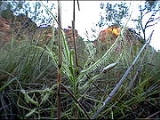
Drosera indica
Encyclopedia
Drosera indica is an insectivorous plant
, a sundew
native to tropical countries throughout the world, from Australia
and Asia
to Africa
, but absent from the neotropics. Together with D. hartmeyerorum
it makes up the section
Arachnopus.
herbaceous plant
, supported by a fibrous root system and reaching a height of 5–50 cm (2–20 in). Leaves are narrowly linear, up to 10 cm [4 in] long with 1-1.5 cm [0.4-0.6 in] pedicels. Young plants stand upright, while older ones form scrambling stems with only the newest growth exhibiting an upright habit. The plant can be yellow-green to maroon in color. Flower petals can be white, pink, orange, or purple. Its chromosome count is 2n=28.
Carnivorous plant
Carnivorous plants are plants that derive some or most of their nutrients from trapping and consuming animals or protozoans, typically insects and other arthropods. Carnivorous plants appear adapted to grow in places where the soil is thin or poor in nutrients, especially nitrogen, such as acidic...
, a sundew
Sundew
Drosera, commonly known as the sundews, comprise one of the largest genera of carnivorous plants, with at least 194 species. These members of the family Droseraceae lure, capture, and digest insects using stalked mucilaginous glands covering their leaf surface. The insects are used to supplement...
native to tropical countries throughout the world, from Australia
Australia
Australia , officially the Commonwealth of Australia, is a country in the Southern Hemisphere comprising the mainland of the Australian continent, the island of Tasmania, and numerous smaller islands in the Indian and Pacific Oceans. It is the world's sixth-largest country by total area...
and Asia
Asia
Asia is the world's largest and most populous continent, located primarily in the eastern and northern hemispheres. It covers 8.7% of the Earth's total surface area and with approximately 3.879 billion people, it hosts 60% of the world's current human population...
to Africa
Africa
Africa is the world's second largest and second most populous continent, after Asia. At about 30.2 million km² including adjacent islands, it covers 6% of the Earth's total surface area and 20.4% of the total land area...
, but absent from the neotropics. Together with D. hartmeyerorum
Drosera hartmeyerorum
Drosera hartmeyerorum is a summer-growing annual sundew that is native to the north of Western Australia. It was discovered in 1995 by Siegfried and Irmgard Hartmeyer. Drosera hartmeyerorum has long scrambling leaves which readily curl around any unfortunate insect that lands on the leaves...
it makes up the section
Section (botany)
In botany, a section is a taxonomic rank below the genus, but above the species. The subgenus, if present, is higher than the section, and the rank of series, if present, is below the section. Sections are typically used to help organise very large genera, which may have hundreds of species...
Arachnopus.
Description
D. indica is an unbranched, annualAnnual plant
An annual plant is a plant that usually germinates, flowers, and dies in a year or season. True annuals will only live longer than a year if they are prevented from setting seed...
herbaceous plant
Herbaceous plant
A herbaceous plant is a plant that has leaves and stems that die down at the end of the growing season to the soil level. They have no persistent woody stem above ground...
, supported by a fibrous root system and reaching a height of 5–50 cm (2–20 in). Leaves are narrowly linear, up to 10 cm [4 in] long with 1-1.5 cm [0.4-0.6 in] pedicels. Young plants stand upright, while older ones form scrambling stems with only the newest growth exhibiting an upright habit. The plant can be yellow-green to maroon in color. Flower petals can be white, pink, orange, or purple. Its chromosome count is 2n=28.

